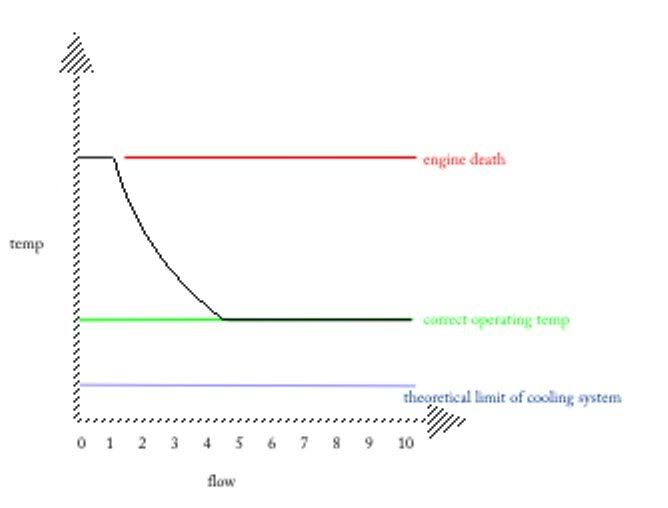Itsaford... on reflection I am not sure whether what you think I'm saying, and what I'm actually saying, are the same thing. If you look at the original post, Ludacris got advice that the "the water maybe flowing too fast", causing his engine to get too hot. I am saying this advice is wrong and suggested he should be looking at his airflow.
If you think that Ludacris's engine may be getting too hot because his water pump(s) are flowing too much coolant, please say so as otherwise I am not sure what the discussion is.
jacked wrote:if water is flowing too fast through an engine block it will not have sufficent time to absorbe heat from the engine.
This is dead wrong. PLEASE show me the page in your textbook where it says this.
We are not talking about a case where the thermostat has been removed. Sure, an engine with the thermostat removed may have cooling problems. However they are not because of "too much flow", they are because the design of the engine requires a thermostat to be present to control
where the flow is happening. A better example would be a thermostat that is stuck open, which will always result in the engine running cooler (or as hot, but
not hotter) than it would with a working thermostat (all else being the same).
(Obviously I don't mean "more coolant flow but without worrying about whether the flow goes through the whole water jacket like it's meant to".)
To say "water takes time to absorbe heat" in the sense you are saying it is just incorrect. Water (or air, or whatever) will absorbs heat at a rate per second, or a rate per microsecond, or a rate per nanosecond, but in the tiniest fraction of a second it will absorb some heat and if it then flows along to the radiator to shed that heat, it doesn't matter because the next little bit of water has come along to absorb some more heat. The difference is that when it is moving faster the system as a whole becomes more efficient.
Jacked wrote:20L of water throwen in a hot cast iron pot for a minute will reduce the temp off the metal . all compared to 10L put in there for 2 minutes (provided the same surface area)
I'm going to assume we are not talking about a pot that's over boiling temp, because that would be boiling off water which is a different thing.
I am not sure about your example but let me tweak it a bit to show something that I am sure about and that is more relevant.
Here goes: if you put 20L of water into your hot cast iron pot for two minutes, it will shed more heat in the first minute than in the second minute, more in the first second than the next second, more in the first 1/10 of a second than the next 1/10 of a second. The best microsecond of heat transfer is the first one, when the temperature difference between the pot and the water is at its maximum.
That is why it will initially cool quite noticeably, then the cooling will taper off and the last bit of warmth in it will take a while to dissipate.
Anyway, how about we go into my backyard and do a different experiment, using an old Mazda wreck I have sitting there. Here's the experiment:
1. We will give the thermostat a whack with my big shifter so that it is stuck fully open.
2. We'll replace the stock water pump with an electric one that has an adjustable flow rate... just a big dial from zero to 10, zero is no flow, five is about the same as the stock pump, 10 is twice as much flow.
3. We'll put the electric fan (there's no mechanical fan) direct to the battery so it's always running.
4. We'll conduct our experiment in constant weather conditions just to be extra careful.
Then we'll start the motor and let it run at, say, 2500rpm for an hour or so at each of the eleven different settings on the dial and plot out what the stable temperature ends up being with different coolant flow rates.
What do you think will happen? At zero or low flow rates the engine will overheat and die. At some flow rate, say around 4-5, the engine will sit at roughly it's normal operating temperature. At higher flow rates it will run cool, approaching a limit based on the radiator size, fan performance, and ambient air temp.
In fact, it will do something like this:

I understand you think I am wrong. Fair enough. So, what do you think would happen instead?
ps just for kicks, this is what it would do with the thermostat working:

If you are in the left side of the graphs, you need to look at your water pump. If you are in the right hand side (but still having overheating issues) then your blue line is too close to your green line (or is above it) and you need to look at air flow, rad size, etc.

